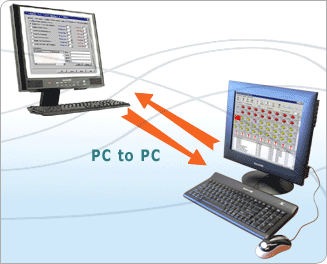|
|
 |
|
|
A direct translation of voice-over-Internet-Protocol
(voice over IP or VoIP) means the ability to carry out voice
communication through the world wide web (www). The world wide web is also
commonly referred to as the internet. In actual fact, voice over IP extends
beyond voice communication. It not only enables voice but text, images, files,
programs, etc to be transferred.
|
Voice over IP is a revolution
over the traditional way of communication since the invention of the telephone
by Alexander Graham Bell in 1876. It combines the legacy voice system with
packet networks and allows both voice data and signaling information to be
transported over the packet network.
When we pick up the telephone handset to make a call, all noises including our
voice messages are captured by the microphone in the handset. They are
converted into analog signals (resembling waveform) and carried across wired
cables from our telephone switch to the telephone switch of the party we
called. The network through which the analog signals are transferred is known
as the PSTN (Public Switched Telephone Network). To ensure that the signals
remain strong after traveling long distances, amplifiers are placed at
strategic junctures along the journey to boost the analog signals.
Unfortunately the unwanted noise signals were also magnified along with the
voice signals. When the signals reach the telephone switch of our intended
listener, they are translated so that the person we called can hear our voice
message. Hence the quality of the original voice message is distorted. Surely
everyone has experience interferences (noise) in the voice communication via
the telephone line.
|
|

|
|
|
In voice-over-Internet-Protocol , the voice message is
converted into digital data represented by 1’s and 0’s and divided into (IP)
packets before being transported across the network. Digital signals carrying
call information are also transported along the same network. Once they reach
the destination, the packets are reassembled and translated back to whatever
form they took before they were converted, which in this example is a voice
message. In order to boost the signals, repeaters (digital amplifiers) were
placed at strategic junctures to magnify the signals. Unlike the amplifiers
used for PSTN lines, the repeaters also clean the digital signals by removing
the unwanted noises before magnifying the signals. Hence the quality of the
original communication is maintained.
As a result of the consistent quality of communication, digital networks are
suitable for transferring more than mere voice messages. Images, text, files,
programs, etc can also be treated in the same manner as voice messages and sent
over the digital network. Another plus factor is the flexibility of digital
bandwidth. This empowers communication media such as text, images, files and
programs can be sent as digital networks can provide the large bandwidth
required for such communication. This development gives new meaning to
communication as we know it. Voice-over-Internet-Protocol utilizes digital
networks to expand the horizons of communication.
|
|
|
 |
|
|
|
|
As the rapid advancement of technology gains momentum,
voice-over-Internet-Protocol may well replace the traditional telephone as the
favored mode of communication tool between customers and businesses. As of now,
its benefits already extend beyond immediate savings in communication costs. It
improves customer relationship and increases productivity of telephone agents.
The rich multimedia possibilities it offers can be used to simulate most office
functions including meetings, conferences, seminars, discussions and even
training. The voice-over-Internet-Protocol is an option offered by the
PowerX-2025™ telecom server. It can support and is beneficial to all
organizations; regardless of size.
|
| Top |
|
|
|
|
|
| Top |
| |
|
|
|
|
|